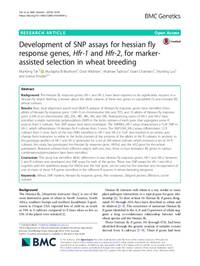Development of SNP assays for hessian fly response genes, Hfr-1 and Hfr-2, for marker-assisted selection in wheat breeding

Authors:
Background
The Hessian fly response genes, Hfr-1 and Hfr-2, have been reported to be significantly induced in a Hessian fly attack. Nothing is known about the allelic variants of these two genes in susceptible (S) and resistant (R) wheat cultivars.
Results
Basic local alignment search tool (BLAST) analysis of Hessian fly response genes have identified three alleles of Hessian fly response gene 1 (Hfr-1) on chromosome 4AL and 7DS, and 10 alleles of Hessian fly response gene 2 (Hfr-2) on chromosome 2BS, 2DL, 4BS, 4BL, 5AL and 5BL. Resequencing exons of Hfr-1 and Hfr-2 have identified a single nucleotide polymorphism (SNP) in the lectin domain of each gene that segregates some R sources from S cultivars. Two SNP assays have been developed. The SNP883_Hfr-1assay characterizes a ‘G/A’ SNP in Hfr-1, which differentiates 14 Hessian fly R cultivars from S ones. The SNP1294_Hfr-2 assay differentiates 12 R cultivars from S ones. Each of the two SNPs identified in Hfr-1and Hfr-2 is ‘G/A’ and resulted in an amino acid change from isoleucine to valine in the lectin domain of the proteins of the alleles in the R cultivars. In addition to the genotype profiles of Hfr-1 and Hfr-2,generated for a set of 249 wheat cultivars which included a set of 39 R cultivars, this study has genotyped the Hessian fly response gene, HfrDrd, and the H32 gene for the wheat germplasm. Resistant cultivars from different origins with one, two, three or four resistance (R) genes in various combinations/permutations have been identified.
Conclusion
This study has identified allelic differences in two Hessian fly response genes, Hfr-1 and Hfr-2, between S and R cultivars and developed one SNP assay for each of the genes. These two SNP assays for Hfr-1 and Hfr-2, together with the published assays for HfrDrd and the H32 gene, can be used for the selection and incorporation of one or more of these 4 R genes identified in the different R sources in wheat breeding programs.
